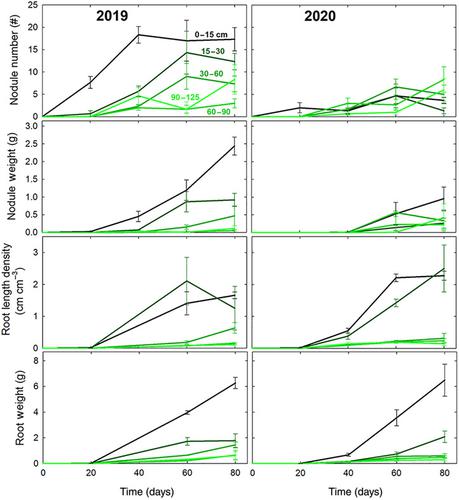当前位置:
X-MOL 学术
›
Ann. Appl. Biol.
›
论文详情
Our official English website, www.x-mol.net, welcomes your
feedback! (Note: you will need to create a separate account there.)
The root system of guar: Spatial and temporal analysis of root and nodule development
Annals of Applied Biology ( IF 2.2 ) Pub Date : 2021-04-15 , DOI: 10.1111/aab.12697 Jennifer MacMillan 1 , Rajan Shrestha 1 , Curtis B. Adams 1, 2 , Philip O. Hinson 1 , Calvin Trostle 1
Annals of Applied Biology ( IF 2.2 ) Pub Date : 2021-04-15 , DOI: 10.1111/aab.12697 Jennifer MacMillan 1 , Rajan Shrestha 1 , Curtis B. Adams 1, 2 , Philip O. Hinson 1 , Calvin Trostle 1
Affiliation

|
Guar (Cyamopsis tetragonoloba [L.] Taub.) is a leguminous crop plant produced in semi-arid regions worldwide, primarily for industrial uses of guar gum. Little research has been conducted on critical belowground traits of the plant, particularly on spatial and temporal development of the root system, including nodules. Providing such analysis was the objective of this research. We observed root and nodule character traits at regular time intervals in 130-cm-tall soil columns sectioned by depth in 2 years. In this tap-rooted plant, root weight was greatest at the soil surface (0–15 cm) and decreased with depth. Root length density (RLD) from 0 to 15 cm and 15 to 30 cm soil depths was similar. The RLD and root weight were generally minimal in deeper soil layers, although deeper roots seem to play an important role in water uptake for guar, especially in drought conditions. Compared to most crops, guar has fine rooting and a small root-to-shoot ratio. At all soil depths analysed, ≥86% of root length was comprised of roots <1 mm in diameter, although most were very fine roots <0.5 mm. The root-to-shoot ratio ranged from 0.055 to 0.17 g g−1 over the growing seasons. Significant accumulation of nodule weight occurred by 60 days, as did the first observations of nodule senescence, but nodule growth continued after this time. Most nodules and nodule weight were concentrated near the soil surface and the average weight per nodule decreased with depth, although smaller nodules were present at all depths. Because guar is typically grown in dryland conditions in hot semi-arid regions, nodules near the soil surface may often be susceptible to shedding or loss of function due to dehydration and/or heat stress and the plant may rely on deeper nodules for N fixation. The basic biological information provided in this report is needed to hasten progress in guar genetic improvement and management.
中文翻译:

瓜尔豆根系:根和根瘤发育的时空分析
瓜尔豆( Cyamopsis tetragonoloba)[L.] Taub.) 是一种在全球半干旱地区生产的豆科作物,主要用于瓜尔胶的工业用途。对植物的关键地下特征进行的研究很少,特别是根系的时空发育,包括根瘤。提供此类分析是本研究的目标。我们在 2 年内按深度划分的 130 厘米高的土柱中定期观察根和根瘤特征。在这种直根植物中,根重在土壤表面(0-15 厘米)最大,随着深度的增加而减少。0 至 15 厘米和 15 至 30 厘米土壤深度的根长密度 (RLD) 相似。在较深的土壤层中,RLD 和根重通常最小,尽管较深的根似乎在瓜尔豆的吸水方面起着重要作用,尤其是在干旱条件下。与大多数作物相比,瓜尔豆根系细,根茎比小。在分析的所有土壤深度中,≥86% 的根长由直径 <1 毫米的根组成,尽管大多数是非常细的根 <0.5 毫米。根茎比范围为 0.055 至 0.17 g g-1在生长季节。到 60 天,根瘤重量显着积累,根瘤衰老的第一次观察也是如此,但在此之后,根瘤继续生长。大多数根瘤和根瘤重量集中在土壤表面附近,每个根瘤的平均重量随着深度的增加而降低,尽管在所有深度都存在较小的根瘤。由于瓜尔豆通常生长在炎热的半干旱地区的旱地条件下,靠近土壤表面的根瘤通常容易因脱水和/或热应激而脱落或丧失功能,并且植物可能依赖更深的根瘤来固氮。需要本报告中提供的基本生物学信息来加快瓜尔豆遗传改良和管理的进展。
更新日期:2021-04-15
中文翻译:

瓜尔豆根系:根和根瘤发育的时空分析
瓜尔豆( Cyamopsis tetragonoloba)[L.] Taub.) 是一种在全球半干旱地区生产的豆科作物,主要用于瓜尔胶的工业用途。对植物的关键地下特征进行的研究很少,特别是根系的时空发育,包括根瘤。提供此类分析是本研究的目标。我们在 2 年内按深度划分的 130 厘米高的土柱中定期观察根和根瘤特征。在这种直根植物中,根重在土壤表面(0-15 厘米)最大,随着深度的增加而减少。0 至 15 厘米和 15 至 30 厘米土壤深度的根长密度 (RLD) 相似。在较深的土壤层中,RLD 和根重通常最小,尽管较深的根似乎在瓜尔豆的吸水方面起着重要作用,尤其是在干旱条件下。与大多数作物相比,瓜尔豆根系细,根茎比小。在分析的所有土壤深度中,≥86% 的根长由直径 <1 毫米的根组成,尽管大多数是非常细的根 <0.5 毫米。根茎比范围为 0.055 至 0.17 g g-1在生长季节。到 60 天,根瘤重量显着积累,根瘤衰老的第一次观察也是如此,但在此之后,根瘤继续生长。大多数根瘤和根瘤重量集中在土壤表面附近,每个根瘤的平均重量随着深度的增加而降低,尽管在所有深度都存在较小的根瘤。由于瓜尔豆通常生长在炎热的半干旱地区的旱地条件下,靠近土壤表面的根瘤通常容易因脱水和/或热应激而脱落或丧失功能,并且植物可能依赖更深的根瘤来固氮。需要本报告中提供的基本生物学信息来加快瓜尔豆遗传改良和管理的进展。











































 京公网安备 11010802027423号
京公网安备 11010802027423号